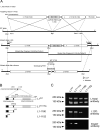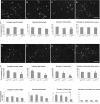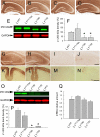Role of the cytoplasmic domain of the L1 cell adhesion molecule in brain development
- PMID: 20127821
- PMCID: PMC3158433
- DOI: 10.1002/cne.22267
Role of the cytoplasmic domain of the L1 cell adhesion molecule in brain development
Abstract
Mutations in the human L1CAM gene cause X-linked hydrocephalus and MASA (Mental retardation, Aphasia, Shuffling gait, Adducted thumbs) syndrome. In vitro studies have shown that the L1 cytoplasmic domain (L1CD) is involved in L1 trafficking, neurite branching, signaling, and interactions with the cytoskeleton. L1cam knockout (L1(KO)) mice have hydrocephalus, a small cerebellum, hyperfasciculation of corticothalamic tracts, and abnormal peripheral nerves. To explore the function of the L1CD, we made three new mice lines in which different parts of the L1CD have been altered. In all mutant lines L1 protein is expressed and transported into the axon. Interestingly, these new L1CD mutant lines display normal brain morphology. However, the expression of L1 protein in the adult is dramatically reduced in the two L1CD mutant lines that lack the ankyrin-binding region and they show defects in motor function. Therefore, the L1CD is not responsible for the major defects observed in L1(KO) mice, yet it is required for continued L1 protein expression and motor function in the adult.
(c) 2009 Wiley-Liss, Inc.
Figures









Similar articles
-
Decreased anxiety, altered place learning, and increased CA1 basal excitatory synaptic transmission in mice with conditional ablation of the neural cell adhesion molecule L1.J Neurosci. 2003 Nov 12;23(32):10419-32. doi: 10.1523/JNEUROSCI.23-32-10419.2003. J Neurosci. 2003. PMID: 14614101 Free PMC article.
-
L1-mediated branching is regulated by two ezrin-radixin-moesin (ERM)-binding sites, the RSLE region and a novel juxtamembrane ERM-binding region.J Neurosci. 2005 Jan 12;25(2):395-403. doi: 10.1523/JNEUROSCI.4097-04.2005. J Neurosci. 2005. PMID: 15647482 Free PMC article.
-
First case of L1CAM gene mutation identified in MASA syndrome in Asia.Congenit Anom (Kyoto). 2005 Jun;45(2):67-9. doi: 10.1111/j.1741-4520.2005.00067.x. Congenit Anom (Kyoto). 2005. PMID: 15904436
-
CRASH syndrome: does it teach us about neurotrophic functions of cell adhesion molecules?Neuroscientist. 2010 Aug;16(4):470-4. doi: 10.1177/1073858410365561. Neuroscientist. 2010. PMID: 20817921 Review.
-
L1 Syndrome.2004 Apr 28 [updated 2021 Jan 7]. In: Adam MP, Feldman J, Mirzaa GM, Pagon RA, Wallace SE, Amemiya A, editors. GeneReviews® [Internet]. Seattle (WA): University of Washington, Seattle; 1993–2025. 2004 Apr 28 [updated 2021 Jan 7]. In: Adam MP, Feldman J, Mirzaa GM, Pagon RA, Wallace SE, Amemiya A, editors. GeneReviews® [Internet]. Seattle (WA): University of Washington, Seattle; 1993–2025. PMID: 20301657 Free Books & Documents. Review.
Cited by
-
Conditional deletion of L1CAM in human neurons impairs both axonal and dendritic arborization and action potential generation.J Exp Med. 2016 Apr 4;213(4):499-515. doi: 10.1084/jem.20150951. Epub 2016 Mar 21. J Exp Med. 2016. PMID: 27001749 Free PMC article.
-
L1CAM and its cell-surface mutants: new mechanisms and effects relevant to the physiology and pathology of neural cells.J Neurochem. 2013 Feb;124(3):397-409. doi: 10.1111/jnc.12015. Epub 2012 Dec 10. J Neurochem. 2013. PMID: 22973895 Free PMC article.
-
EphB regulates L1 phosphorylation during retinocollicular mapping.Mol Cell Neurosci. 2012 Jun;50(2):201-10. doi: 10.1016/j.mcn.2012.05.001. Epub 2012 May 8. Mol Cell Neurosci. 2012. PMID: 22579729 Free PMC article.
-
Polarized targeting of L1-CAM regulates axonal and dendritic bundling in vitro.Eur J Neurosci. 2010 Nov;32(10):1618-31. doi: 10.1111/j.1460-9568.2010.07447.x. Epub 2010 Oct 21. Eur J Neurosci. 2010. PMID: 20964729 Free PMC article.
-
α1ACT Is Essential for Survival and Early Cerebellar Programming in a Critical Neonatal Window.Neuron. 2019 May 22;102(4):770-785.e7. doi: 10.1016/j.neuron.2019.02.036. Epub 2019 Mar 25. Neuron. 2019. PMID: 30922876 Free PMC article.
References
-
- Alamed J, Wilcock DM, Diamond DM, Gordon MN, Morgan D. Two-day radial-arm water maze learning and memory task; robust resolution of amyloid-related memory deficits in transgenic mice. Nat Protoc. 2006;1(4):1671–1679. - PubMed
-
- Barbin G, Aigrot MS, Charles P, Foucher A, Grumet M, Schachner M, Zalc B, Lubetzki C. Axonal cell-adhesion molecule L1 in CNS myelination. Neuron Glia Biol. 2004;1(1):65–72. - PubMed
-
- Brittis PA, Lemmon V, Rutishauser U, Silver J. Unique changes of ganglion cell growth cone behavior following cell adhesion molecule perturbations: a time-lapse study of the living retina. Mol Cell Neurosci. 1995;6(5):433–449. - PubMed
-
- Castellani V. The function of neuropilin/L1 complex. Adv Exp Med Biol. 2002;515:91–102. - PubMed
Publication types
MeSH terms
Substances
Grants and funding
LinkOut - more resources
Full Text Sources
Molecular Biology Databases
Research Materials

